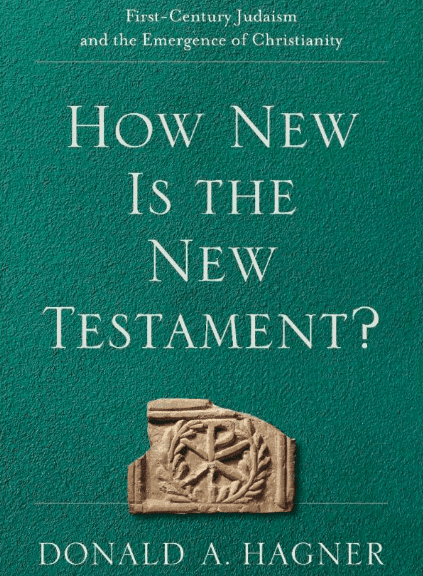 In his new book, How New is the New Testament?, Don Hagner carries on the good fun at Fuller Seminary in responding kindly to John Goldingay’s Do We Need the New Testament? Hagner says this about the famous saying of Jesus, which reads:
In his new book, How New is the New Testament?, Don Hagner carries on the good fun at Fuller Seminary in responding kindly to John Goldingay’s Do We Need the New Testament? Hagner says this about the famous saying of Jesus, which reads:
Matthew 13:51-52: Have you understood all this?” They answered, “Yes.” And he said to them, “Therefore every scribe who has been trained for the kingdom of heaven is like the master of a household who brings out of his treasure what is new and what is old.”
Hagner comments:
“Matthew’s Gospel is above all the announcement of something dramatically new, and it is no accident that he refers to what is new first and emphatically. New and old are both important to Matthew, but it is the new that captivates him, and it is above all the new that he writes about in his Gospel” (p. 9).
What happens, all this is leading us to ask, to teaching Old Testament if these New-Thematizers have their way? What happens, as well, to homiletics? What happens to NT exegesis? Can we read the Bible as the apostles read the Bible?
The bottom of this issue is continuity between the testaments (Goldingay, new perspective) or discontinuity (Hagner, old and apocalyptic perspectives). And not all new and new fit on that scale that simply. But, we’ll start there because that’s where Hagner more or less begins.
It is evident that the issue here is not merely sociological but also soteriological and thus an issue of universal significance, for both Jews and Gentiles. The law had only a temporary role to play in the pursuit of righteousness, and that role has come to an end with the coming of Christ. As in so much of what the NT has to say, a key turning point has now been reached in the history of salvation. We are in a new situation…. ‘he radical difference in the new situation is the dynamic by which righteous living is now possible, namely, the empowering of the Holy Spirit, which so characterizes the remarkable newness that arrives with the coming of the Christ. The Holy Spirit thus accomplishes what the law could not (4).
It doesn’t take long for Hagner to enter the fray with some sword flashing:
The balance between covenant grace and works of the law was lost in postexilic Israel. The experience of the exile understandably drove the Jews to observance of the law with a renewed dedication and energy. The result appears to have been a legalism that became dominant and all but obscured the reality of covenant grace. Under these circumstances, it should not be surprising to discover that many or even most Jews of Paul’s day were de facto legalists, in contradiction to a proper understanding of covenant grace. Paul is not necessarily arguing against straw men, as many scholars claim (5).
What now to make of Jesus’ words about rewards? Paul’s statements about rewards and works? John’s relentless requirement to be obedient? Are they all legalists, too? I’ll move on…
Hagner disagrees strenuously with the Paul-within-Judaism crowd of scholars (M Nanos, M Zetterholm, P Eisenbaum, etc).
The so-called “historical” readings of the Paul-within-Judaism scholars can often make sense of the Pauline texts only by means of a tortuous exegesis (9)…. The advocates of the Paul-within-Judaism perspective give insufficient consideration to the complexity of reality. They confront their readers with a kind of rigid either/or mentality that fails to allow tensions, nuances, and subtleties in Paul’s affirmations. There is often a sense in which both sides of an either/or can be true and when it is necessary to conclude both/and. This is especially so in the present case, where we are dealing with the genealogical relationship of promise and fulfillment, the new flower growing out of the old seed (10).
Here, on p. 11, Hagner gives a precis of his fuller argument:
Paul’s Christianity is fulfilled Judaism. It therefore is incorrect to say that Paul left Judaism for Christianity. For Paul, Christianity is the goal of Judaism. But Paul’s fulfilled Judaism is not adequately described as simply one Jewish sect among others. Far from being one form of Judaism among other equally acceptable forms, Christianity for Paul has an absolute character as the expression of the true Judaism of the end time, an eschatologically fulfilled Judaism. “What God was creating through Paul’s mission was not another form of ‘Judaism,’ but something different and new” [citing John Barclay].
The emphasis of Hagner is on what is new and on discontinuity, but it’s not because he denies continuity. His is not an apocalyptic approach but a newness emphasis in the dialectic of new and old, discontinuity and continuity.
Christianity is not other than Judaism: it is the fulfillment of Judaism. The early church was at first entirely Jewish; although it remained a sect within Judaism for a very short time, Christianity is to be understood as a fulfilled Judaism and can be described as a Judaism coming to its divinely intended goal: the accomplishment of salvation through the Messiah’s death and the full inclusion of believing Gentiles in the people of God (20).
What most do not recognize about this debate today is pluralism, which drives many to avoid speaking of discontinuity and fulfillment.











